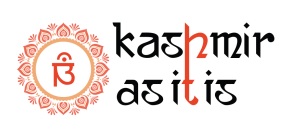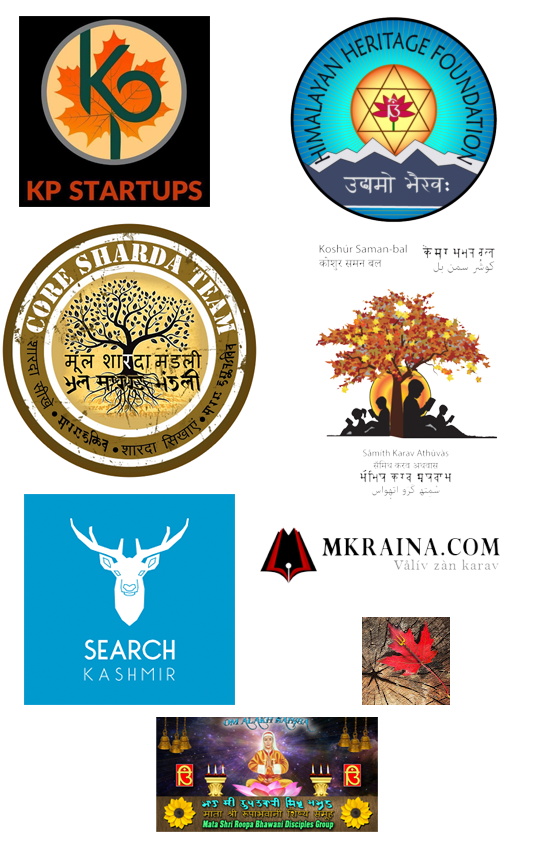 been an object of veneration for people living in Kashmir. It is a physical embodiment of the victory over demonic forces. Legend prevalent among Kashmiri Pandits is that this valley was originally a huge lake, where a demon named Jalodbhava resided. Seeking relief from his atrocities, the natives prayed to Goddess Parvati for help. She turned into a bird (Mynah) and dropped a pebble on the demon’s head. The pebble kept increasing in size until the demons head was crushed. It is said that Hari Parbat is the same enlarged pebble, which became the abode of gods.
been an object of veneration for people living in Kashmir. It is a physical embodiment of the victory over demonic forces. Legend prevalent among Kashmiri Pandits is that this valley was originally a huge lake, where a demon named Jalodbhava resided. Seeking relief from his atrocities, the natives prayed to Goddess Parvati for help. She turned into a bird (Mynah) and dropped a pebble on the demon’s head. The pebble kept increasing in size until the demons head was crushed. It is said that Hari Parbat is the same enlarged pebble, which became the abode of gods.
Hari Parbat has always been an object of fascination/ veneration for me. From the east facing windows of our house in Srinagar, it was clearly visible. Two members of our family were DAILY VISITORS to the shrine, – my late grandfather and my father’s Chachi, Jigri. Both would perform a pradakshina(circumambulation) of the hill (Hari Parbat) daily having various temples/ shrines located all along the route! Offering worship at Hari Parbat DAILY was a very well accepted tradition amongst Kashmiri Pandits of Srinagar. People across the city would trek to the shrine, in snow and summer every morning.
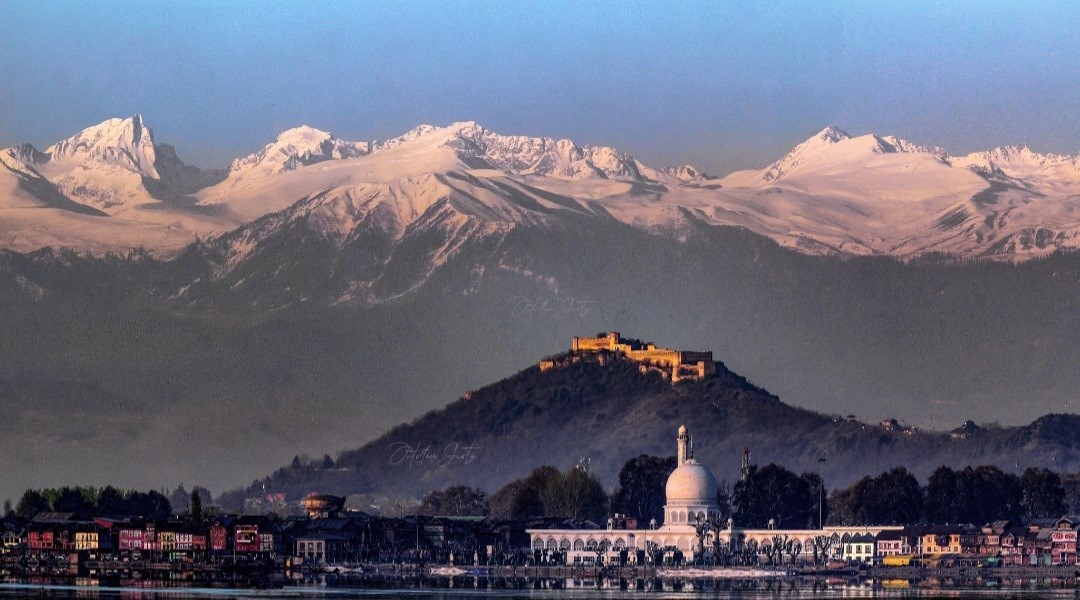
Hari Parbat Fort with the Karakoram mountain range in the backdrop

Hari Parbat – View from Shankaracharya Hill
I remember going to Hari Parbat with Jigri whenever I was in Srinagar – she would start pretty early, mostly by 4.30 am, on foot. My grandfather would start a bit late as he had a different routine. For people coming from Safa Kadal, Nawa Kadal, Ali Kadal areas of downtown, the route would be via Rajouri Kadal (Nallah Maer), Islamia School, Gojwara, crossing the Ganderbal road to the precincts of the Hari Parbat. People coming from Zainakadal and surrounding areas would take a slightly different route but would converge at the Gojwara crossing. Another road would bring the Habbakadal side pilgrims to the base of the hill, where one could see the remnants of old Mogul era protective wall called Kalai.
Our first stop would be a Ganesh Temple, colloquially called Ganishisund (Ganesh’s abode), just inside the outer parapet boundary or Kalai. The aarti was the fabulous ‘Hemja Sutam Bhaje Ganesham, Eiesha Nandanam, Ek Dante Vakre Tunde, Naag Yagya Sutrakam”, sung in a very typical sing-song tune. Every family had a specific pujari who would provide the Pooja Lamp (tchong – in Kashmiri) and other required material for aarti/pooja. After leaving Ganishisund, we would enter a lovely gradient meadow rising towards the hill called Devi Angan(pronounced Deevee Angan in colloquial Kashmiri) . This was very sacred ground with several legends associated. One such legend, was about a Chinar Tree; after crossing the meadow and climbing a small gradient, there used to be a Chinar tree to the right called Saptrishi, supposed to be the birthplace of the eternal Saptrishis. People used to do pradakshina around this tree. Near the tree, slightly towards the hill side, there was a Kali temple. This place was not frequently visited by common devotees. My grandfather and other learned people would prefer to meditate near this temple, in the open.
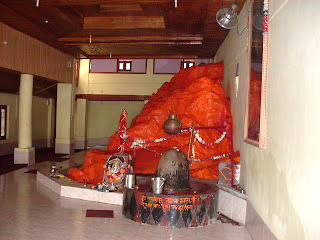
Lord Ganesh as worshipped in rock form at Ganishisund
Another legend was about a stop/spot called ‘Haeree’, named after the Devi who had killed the giant, Jalodbhava. The legend goes that Kashmir used to be a lake called Satisar wherein the Nagas resided. A water demon, Jalodbhava, grew there and terrorised the peaceful inhabitants. A great sage and descendant of Brahma, Maharishi Kashyap, in a long penance to Lord Vishnu, prayed to rid the lake of its demon. Lord Vishnu drained the valley of its water thus killing the demon. On the sage’s request, the Nagas invited humans to inhabit the valley and apparently, this is when the first human civilization began in this beautiful untouched land. Since Kashyap Rishi was responsible for settling this land, it adopted his name – and became known as Kashyapmar, which later appears to have become Kashmir.
Moving on, towards the left were Badamwari or almond orchards. When almond trees are in full bloom, it is a sight to behold. People would throng the area, picnicking and enjoying traditional Kashmiri cuisine like Nadermonj, or Luchi & Kehwa. There would be similar crowds on Navreh (Kashmiri Hindu Nav Samvat). Kashmir has its own calendar, called Saptrishi Samvat, currently recording its 5096th year.

Badamwari in full bloom
Then would come the main shrine, Chakrishwar, on the western slope of Hari Parbat hill. You have to climb a long flight of stairs to reach the temple. This indeed is sacred ground. I remember the eminent Kashmiri painter – Gulam Rasool Santosh telling my Dad about the Tantra symbols that abound in the area, particularly near Chakrishwar and on the stone idol which is smeared with sindoor to hide the swayambhu(arisen on its own) Shree Chakra. Santosh was a great devotee of Shakti and that reflects in his paintings.

“Shakti”, painting of the goddess by Gulam Rasool Santosh created in 1990
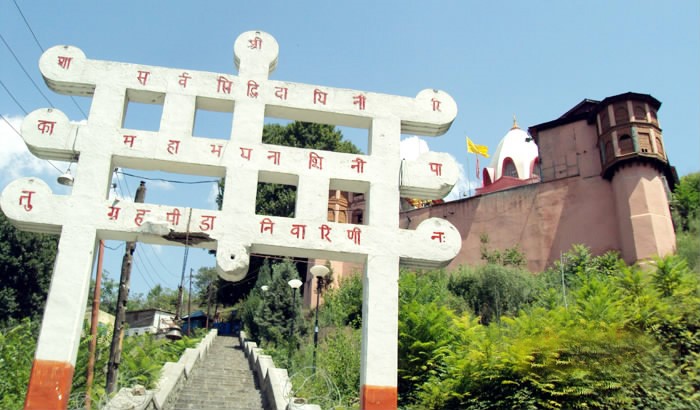
A long flight of stairs leads to the Gate to Sharika Mata Temple
Chakrishwar temple, also known as Predemna Peeth is the abode of Sharika Bhagwati – the presiding deity of Srinagar. Goddess Parvati is worshipped here as the 18-armed Sharika (Ashtadashbhuja). Har Navum (Ninth day of Ashada) – the birth occasion of the Goddess – is celebrated at the temple by offering taher-charvan (turmeric mixed yellow coloured rice and goat liver). During my childhood, I have witnessed people offering goat lungs to eagles after pooja in order to propitiate the Goddess. This Devi, the Aadi Devi or Mother Goddess, is often identified by scholars with Tripurasundari or Lalitha Devi. Hari Parbat is a corruption of the name ShAri, the name for the Myna bird. The temple is unique in more ways than one, for Sharika Devi is worshipped in the form of a svayambhu or self-apparent Sri Chakra on the surface of a rock. This Sri Chakra is what gives the city of Srinagar its name. The temple around the Sri Chakra had in fact been set up by King Pravara Sena II as per Kalhana’s magnum opus on Kashmir history Rajatarangini (12th century CE). This city was then known as Pravarapura, as has been noted by the Chinese traveler Huen Tsang in 6th century AD.
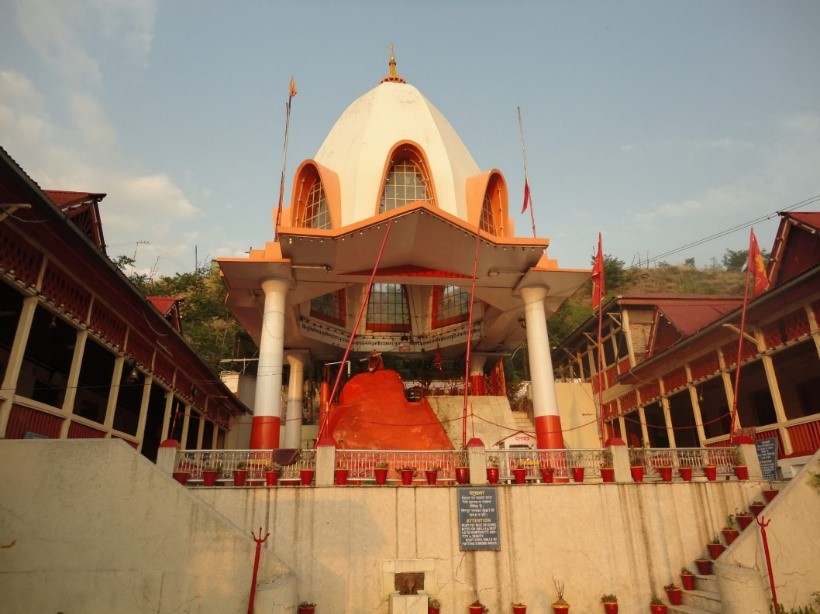
Sharika Peeth, Chakrishwar
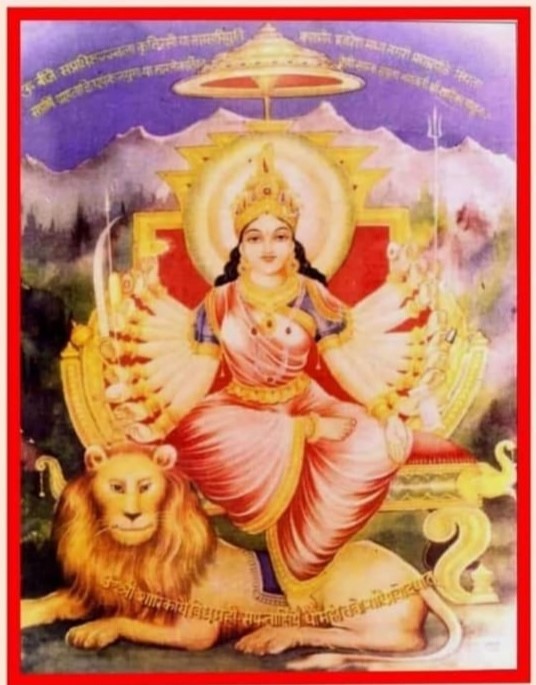
Ashtadash Bhuja Sharika Devi, as depicted by Pt NN Razdan of Kashmir Mercantile Press, in his painting of the Mother Goddess
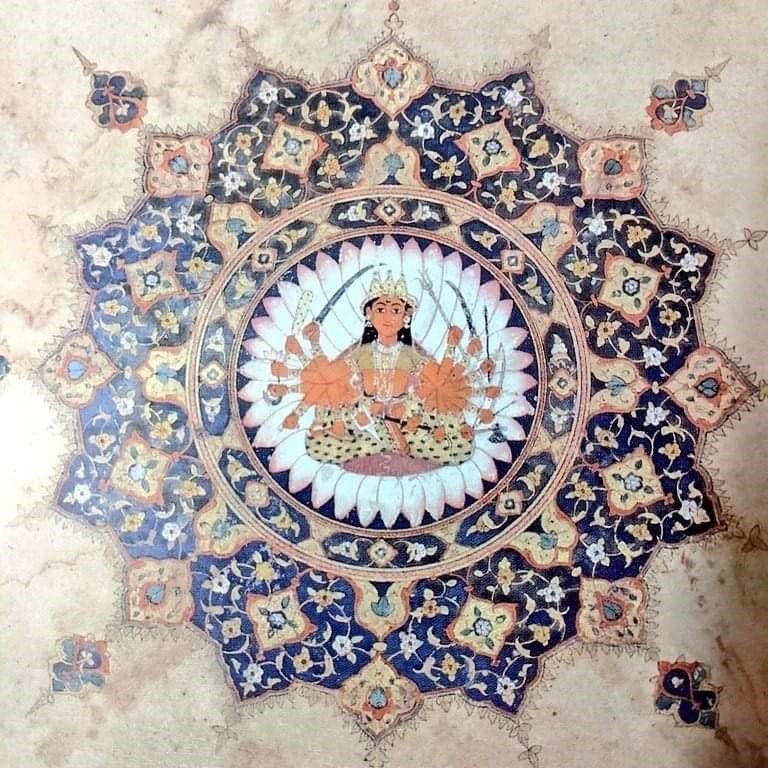
Depiction of Devi Sharika – A form of Shakti (Supreme Goddess) with 18 hands
Krishna Joo Kar, the Guru of Resh Peer, a scholar and administrator during the reign of Aurangzeb (17th century) was said to be a devotee of the Sharika Peeth and would start his day after visiting the shrine daily. Legend has it that while a young Resh Peer was circumambulating the Hari Parbat (he did it on his knees for over 14 years), Divine Mother appeared and told him that the first person he would meet next would be his guru! The person Resh Peer met was Pt Krishna Joo Kar, who is said to have composed a poem in Persian + Sanskrit, praising the Mother:

Kalhan also mentions that Sharika Devi’s Murti(idol) is beautiful. Her image is made of glazed black stone. She is Mother Durga having eighteen arms. The Cosmic Energy is beyond any name and form and She is Eternal force of God. She is matter (Sat), soul (chit) and bliss (ananda). I offer Pranams to Her to protect me, the seeker of asylum under her pious feet. But where is the idol now? Learned scholars of the community have noted that the idol was taken away from the temple in Srinagar sometime between the 11th and the 14th century. Kashmir was first attacked by Mehmud of Ghazni in 1015 AD but was defeated. It was not till 1339 that Kashmir got its first Muslim ruler – Rinchan Shah, a Buddhist prince converted to Islam and ruled as Sadrudin Shahmiri. However, major setback to Hindus was caused by King Sikandar Shahmiri (1389 -1413 AD) who is known as Sikandar Butshikan (iconoclast or breaker of idols). Sikandar caused widespread destruction of Hindu & Buddhist temples in the valley. Folklore suggests that in order to save the Idol of Devi, it was smuggled to Kishtwar and established at a place called Sarthal sometime in the 14th century. Hutchison and Vogel in their history of the Hill States note the name of Ugar Dev as a ruler of Kishtwar during whose reign the idol was brought to Sarthal. People of the region – (Kishtwar, Bhaderwah, Gundoh etc) organize an annual yatra(pilgrimage) to Sarthal – it is considered a tough journey because of the steep gradient and difficult terrain. My late father had the privilege of visiting Sarthal for darshan once. I visited Kishtwar several times but never had the good fortune to visit Sarthal.
Next stop was the Ambyur Kaul Mandir, built by Pt. Ambar Nath Kaul, a renowned philanthropist residing at Alikadal, across Jhelum River. I have a lot of memories of this temple as my Dada Ji’s guru, Swami Ramanand used to live there. Apart from the temple, there was a double storied hut in which sadhus would reside. It also had a nice orchard attached. Opposite this temple was another Shrine, Sidhlakshmi. One had to climb a good number of steps to get to the temple so people would invariably offer salutation to the Devi from the roadside itself.
The road from Chakrishwar to Ambyur Kaul temple offered a panoramic sight of the valley. Beyond the Ambyur Kaul temple, towards the left, almost 1 km off the main road, is a big temple, on the bank of the Dal Lake called Pokherbal. This place is associated with several legends concerning Kashmiri Pandits and it used to be a big center for religious learning. Pokherbal is perhaps the largest of temples in the Parbhat area as far as land and other paraphernalia are concerned. On special occasions, devotees would have a dip in the pokher/nag which was located in the premises of this shrine.
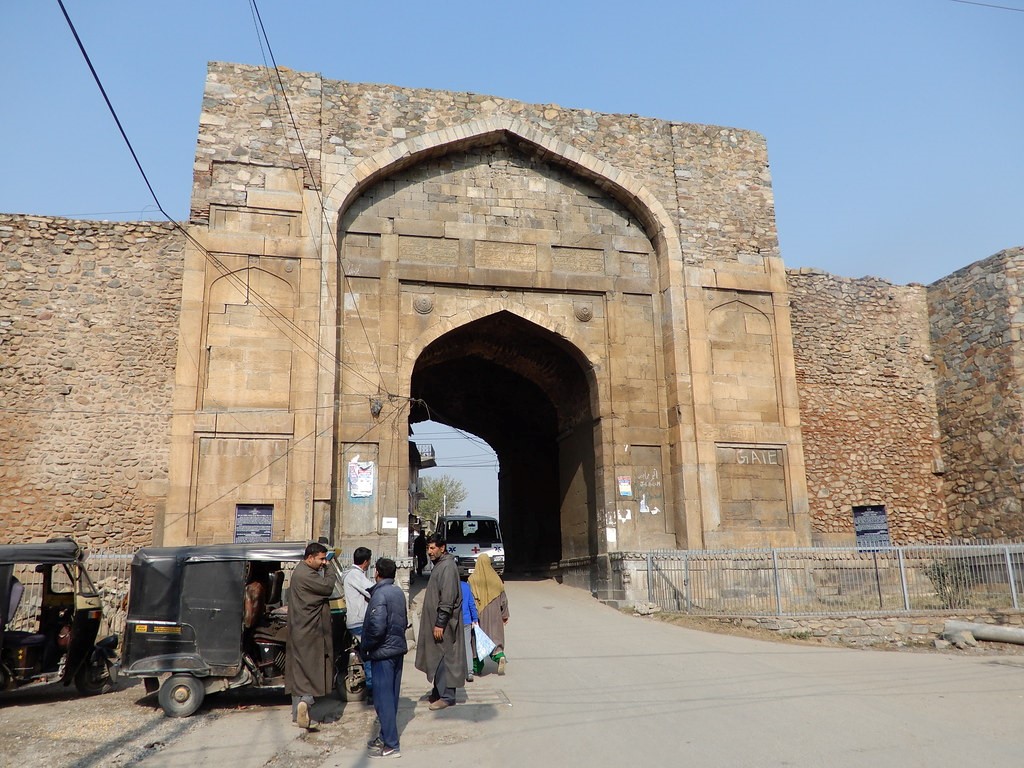
Kathi Darwaza, one of the three gates built in the Kalai( protection wall for the Qila)
Kathi-darwaza, a majestic stone gate, was one of the three openings in the boundary wall (Kalai) surrounding the Hari Parbat. The other two were Beech Darwaza (near the Ganesh Temple- Ganshisund) and Sangeen Darwaza for entering Devi Angan. Kathi-darwaza had another interesting peculiarity – a number of vegetable vendors would gather here in the morning hours, selling fresh farm produce, often at reasonably discounted rates to the devotees. Kathi -darwaza also marked the bifurcation of routes – Rainawari contingent would carry on straight towards the Gurudwara Chatti Padshahi, while rest of the devotees would take the right fork, through Malkhah, the burial grounds. Again, people would take various forks to move towards Habba Kadal and the rest would continue towards Gojwara, Razer Kadal, Budhgir, Ali Kadal and so on.
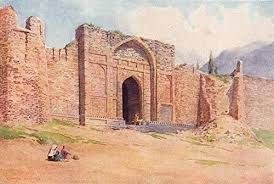
Kalai and the Gate of the outer wall, 1924
Since Hari Parbat is sacred to the Hindus, they could not dream of defacing or constructing any structure on the hill. Successive Muslim rulers, however, had no such constraints. The Hill was renamed Koh-e-Maraan – a typical Muslim maneuver for appropriating what originally belonged to someone else. Another example is the Shankaracharya Hill which is being given a new name – Koh-i-Sulemani. Akbar, the Mogul emperor is said to have initiated building of the fort and its boundary wall (Kalai) in 1590 AD but could not complete it. An Afghan, Shuja Shah Durrani, is said to have completed it in 1808 AD. The Afghans also had built a couple of deep dry wells (called Chah in Kashmiri) in Devi Angan area, probably called Jaffar Khan’s Chah. There was another, probably deeper dry well (Chah) near Ambyur Kaul Mandir called Waris Khan’s Chah. These were often used to punish enemies by dropping them into the Chah – food would occasionally be thrown down to keep them from dying of hunger!
Whatever is forbidden is mostly fascinating, particularly when you are young! I remember going to the Parbat, as we used to call it as part of the Boys Gang of our mohalla – I was probably its youngest member. The seniors decided to visit the Qila (Fort) – a forbidden area, one fine Sunday morning. The approach was via the backside of Chakrishwar temple. We somehow managed to get into the Qila and steal some old cannon balls. And then, we were caught by the ‘Army’ that was based in the Qila. Tongue lashing apart, we probably had to face some physical punishment as well! But I guess those were peaceful times (1964-65) and the Guardians of the Qila let us go without any major scars! Some of the small cannon balls (of the size of golf balls) were still in our pockets as we left the Qila, unscathed. Those, I guess, were at our Budhgir house till our forced exodus in 1990!
Post 1948, the Muslim dominated Administration and political class clandestinely worked towards appropriating Kashmiri Pandit shrines and lands associated with those. Devi Angan/ Badamwari/ Saptrishi encroachment started right from 1950s with administration encouraging local Muslims to construct private residences in the area. As part of this grand plan, it was decided to plant trees on the slopes of the hill, particularly in the Devi Angan meadow and cordon it off with barbed wire in the name of afforestation. Apart from keeping goats & cows away, it also discouraged Hindu devotees from entering the area so traditionally sacred to them.
Exodus in 1990 finally shut the doors for us Kashmiri Pandits! Can we ever hope to go back and reclaim what has been our heritage for past 5000 years? Hope, of course is eternal but then Kashmir has gone through strife, in the name of Islamization for last several decades. The composite culture that was the warp and woof of our social fabric shall remain confined to academic discussions only. Ground reality is that the era we grew up in shall never come back, at least not in the manner my generation or generations prior to mine, knew it.
Disclaimer – KAII does not hold the responsibility for the authenticity of this article. The writer/author of this writeup is responsible for the content displayed. If anyone has any objections, please raise it immediately to admin@kashmirasitis.com with valid reasons.
